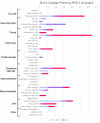Apolipoprotein L1 risk genotypes in Ghanaian patients with systemic lupus erythematosus: a prospective cohort study
- PMID: 33461980
- PMCID: PMC7816898
- DOI: 10.1136/lupus-2020-000460
Apolipoprotein L1 risk genotypes in Ghanaian patients with systemic lupus erythematosus: a prospective cohort study
Abstract
Objective: Two apolipoprotein L1 (APOL1) risk variants (RV) are enriched in sub-Saharan African populations due to conferred resistance to Trypanosoma brucei. These variants associate with adverse renal outcomes by multiple causes including SLE. Despite emerging reports that SLE is common in Ghana, where APOL1 variant allelic frequencies are high, the regional contribution to SLE outcomes has not been described. Accordingly, this prospective longitudinal cohort study tested the associations between APOL1 high-risk genotypes and kidney outcomes, organ damage accrual and death in 100 Ghanaian patients with SLE.
Methods: This was a prospective cohort study of 100 SLE outpatients who sought care at Korle bu Teaching Hospital in Accra, Ghana. Adult patients who met 4 American College of Rheumatology criteria for SLE were genotyped for APOL1 and followed longitudinally for SLE activity as measured by the Safety of Estrogens in Lupus National Assessment-Systemic Lupus Erythematosus Disease Activity Index (SELENA-SLEDAI) hybrid and organ injury as measured by the Systemic Lupus International Collaborating Clinics Damage Index (SDI) at baseline and every 6 months for 1 year. Outcomes of interest were kidney function, SDI and case fatality.
Results: Assuming a recessive inheritance, the APOL1 high-risk genotype (2RV) associated with end-stage renal disease (ESRD) at an OR of 14 (p=0.008). These patients accrued more SDI points particularly in renal and neurological domains. The SDI was 81.3% higher in 2RV patients compared with 0RV or 1RV patients despite no difference in SLE activity (p=0.01). After a 12-month period of observation, 3/12 (25%) of the 2RV patients died compared with 2/88 (2.3%) of the 0RV or 1RV carriers (OR=13.6, p=0.01). Deaths were due to end-stage kidney disease and heart failure.
Conclusion: APOL1 RVs were heritable risk factors for morbidity and mortality in this Ghanaian SLE cohort. Despite no appreciable differences in SLE activity, APOL1 high-risk patients exhibited progressive renal disease, organ damage accrual and a 13-fold higher case fatality.
Keywords: cardiovascular diseases; genetic; lupus erythematosus; lupus nephritis; polymorphism; systemic.
© Author(s) (or their employer(s)) 2021. Re-use permitted under CC BY-NC. No commercial re-use. See rights and permissions. Published by BMJ.
Conflict of interest statement
Competing interests: None declared.
Figures



References
Publication types
MeSH terms
Substances
Grants and funding
LinkOut - more resources
Full Text Sources
Other Literature Sources
Medical
Miscellaneous
